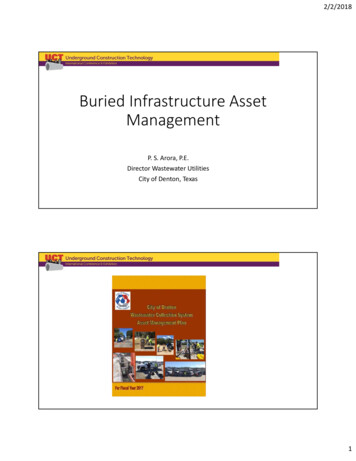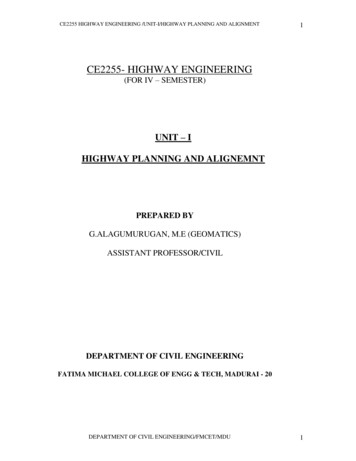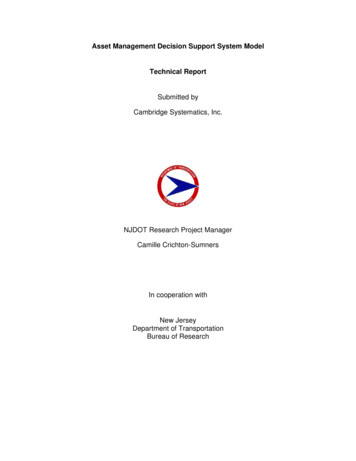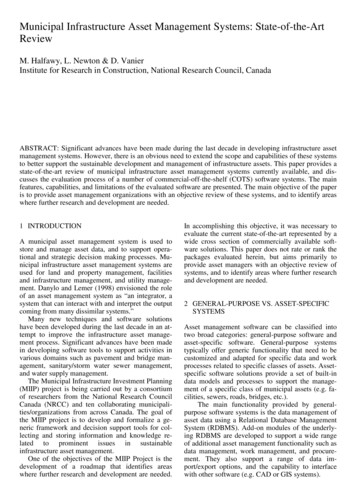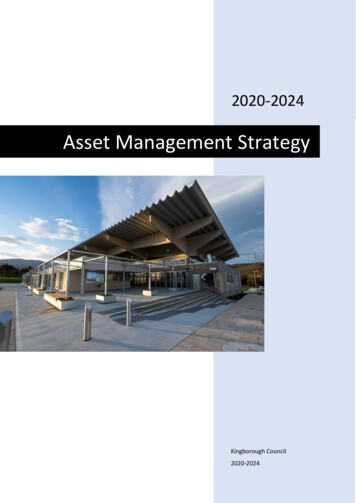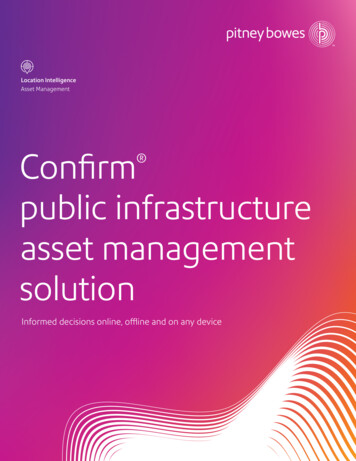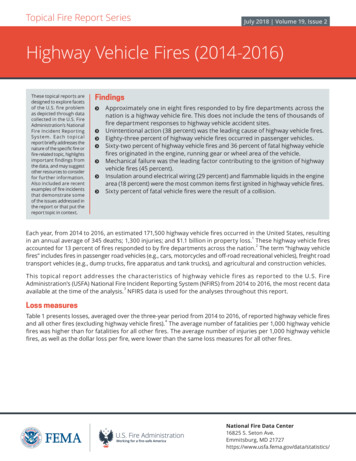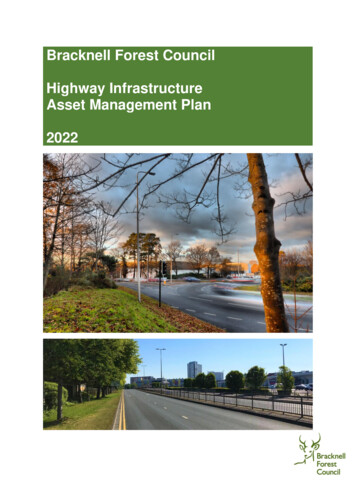
Transcription
Bracknell Forest CouncilHighway InfrastructureAsset Management Plan2022
ContentsIntroduction . 1Leadership & Support . 3Stakeholders . 4Document Control and Review. 5Assets Covered by the HIAMP . 6Knowledge of the Asset . 8Asset Systems . 9Challenges and Opportunities . 10Asset Objectives . 12Annual Infrastructure Asset Management Process . 13Management of Risk and Change . 16Related Plans . 17Appendices . 19
Introduction1. Asset management is a means to deliver a more efficient and effective approach to themaintenance of highway infrastructure assets through long-term planning, ensuring thatstandards are defined and achievable for available budgets. It supports making the casefor funding and better communication with stakeholders, facilitating a greaterunderstanding of the contribution highway infrastructure assets make to economic growthand the needs of local communities.2. This HIAMP sets out the vision for improvements in the management, operation andfunding of the Bracknell Forest highway network. The Council is committed to a consistent,proactive approach, managing the unique maintenance impacts of New Town inheritanceby developing our investment strategies and prolonging the life of our entire highwayinfrastructure. Our approach will seek to make the most efficient use of maintenancefunding by prioritising timely interventions, whilst targeting further relevant fundingopportunities where available.Bracknell ‘new town’ under construction in the 1950s. Whilst the characteristic planned dual carriageways,roundabouts, subways, cycle routes, and distributor roads of the town could still be considered modern inrelative terms, much of the infrastructure is now over 60 years old, presenting unique maintenance challenges.Meanwhile, the towns of Crowthorne and Sandhurst, and the Borough’s surrounding villages are generally builtaround more historic street settings, often requiring a different, more sympathetic approach to highwaymaintenance.Page 1
3. The HIAMP is a strategic document which outlines how the asset management system willmaximise efficiency, deliver value for money and identify key asset objectives for the planperiod. This HIAMP recognises the most up to date standards including the UK RoadsLiaison Group (UKRLG) Highways Efficiency Maintenance Programme’s (HMEP) HighwayInfrastructure Asset Management Guidance, developed by the Department for Transport(DfT) in partnership with the Local Government Association (LGA).4. The highway is the most valuable publicly owned asset managed by Bracknell ForestCouncil. The HIAMP encompasses all parts of the asset and sets out an approach that willconsider and prioritise activities to deliver a comprehensive and effective assetmanagement service. It balances the preservation and enhancement of the highwaynetwork with the best use of resources for the delivery of services to Bracknell Forestresidents and to users of the highway network.Page 2
Leadership & Support1. Leadership and commitment with respect to the asset management systems is critical todeliver the levels of service and asset objectives defined by this HIAMP.2. Responsibility for managing the highway asset rests with Bracknell Forest Council and theorganisational structure, as shown in the structure chart below, reflects the responsibilitiesfor highway policy development and delivery of highway network activities.3. The Corporate Management Team is responsible for ensuring the resources for the assetmanagement system are available and for ensuring the effectiveness of the assetmanagement system.Assistant Director:Highways andTransportHighways and Transport Division organisational structure4. Operation and control of planned work is managed by the Assistant Director: Highwaysand Transport, with specialist support from the engineering management team. The assetmanagement process also involves external companies which provide key specificsupport. Key term-contractors and suppliers include: Ringway Infrastructure Services – highway service term contractor Siemens – traffic signal term contractor Pitney Bowes – CONFIRM asset register Pavement Testing Services – highway condition surveys Atkins – highway structure condition assessments5. Where required, significant one-off projects are procured on a project by project basis inaccordance with the Council’s procurement procedures. Competency of all outsourcedactivities and the awareness of the HIAMP and asset management system is ensured.Appropriate insurance and accreditation will be held by third partiesPage 3
Stakeholders1. The Council is committed to ongoing engagement with residents and other keystakeholders in the delivery of services and will ensure regular opportunities to review andimprove performance. It is recognised that feedback informs decision-making and servicedelivery and so stakeholder engagement and feedback forms part of the highway assetmanagement system.2. The Council publishes funding allocation and work programme reports along with resultantapproval decisions by the Executive. Customer feedback through enquires, complaints andcompliments are monitored to ensure service standards are maintained and improvementsidentified. Delivery of targeted communication plans are used to present and explain theCouncil’s highway engineering work.3. Regular formal and informal briefing sessions on the HIAMP for relevant staff will ensurethat individuals can have an impact on the achievement of the asset managementobjectives through awareness of: The asset management policy; Their contribution to the effectiveness of the asset management system; Their work activities, associated risks and opportunities; The implications of not conforming to the asset management systemrequirements.4. The HIAMP will also be a relevant reference document for designers in the preparation ofhighway improvement schemes.Page 4
Document Control and Review1. The HIAMP is displayed on the Bracknell Forest Council website for public access. Thedocument will be reviewed regularly by the Assistant Director: Highways and Transportand any interim and minor amendments endorsed by the Executive Member for Planningand Transport.2. An annual review will consider: Performance of the asset over the previous period including condition trends; Changes in process and issues relevant to the management system; Contractor and supply chain performance; Industry developments; Opportunities for continuous improvement.3. In addition, a more comprehensive review of the HIAMP will be undertaken periodically(typically every 5 years) and formally approved by the Council. This review will considerimpacts upon the asset management system with regard to:Page 5 Forward financial planning based on Government grant allocations; Review of Government policy and guidance on asset management ; Assessment of emerging highway risks; Assessment of asset condition against expectations; The Council Plan; Links to wider strategies, e.g. Climate Change, Public Health, Transport.
Assets Covered by the HIAMP1. The HIAMP applies to the whole of the highway network and covers the full range of assetcomponents that exist within Bracknell Forest Council’s responsibility. These assets aredetailed in the tableQuantityKey AssetA Class RoadsB Class RoadsC Class RoadsUnclassifiedRoadsRoads – Total length (Km)48.742.744.5323.9Roads – Urban length (Km)18.331.439.0291.9Roads – Rural length (Km)30.411.35.532.0Roads urban – Area (m2)209,457212,663385,8211,277,889Roads rural – Area (m2)337,45996,48570,917135,216Central res. – Length (Km)14.8390.5980.2290.038Central res. – Area (m2)37,097.51,495.0572.595.0Footways/Cycle tracks (Km)33.61857.54248.123395.648Footways/Cycle tracks (m2)60,774118,234112,186755,454Kerbs – length Km121.07880.65582.224476.800Gullies - No.2,8083,0232,80812,959Lines hatched – length (m2)13,52222,59413,20440,918Longitudinal lines - (Km)83.43254.65240.758138.725Road Markings - No.2,3142,0978714,998Veh. Safety Fence - (Km)2.46102.8760Ped. Guard Rail - (Km)5.9540.8510.9986.004Signs (non illum) – No.1,3618591,4744,998Signs (illuminated) – No.1135514242533Bollards – No.389632358448Lighting columns1761172745010200Traffic Signals (heads)6031010112Structures – Road Bridges34Structures – Underpass74Structures – Footbridges41Structures – Culverts13Structures – Retaining wall19Structures – Gantry/CCTV12Page 6
2. The HIAMP covers the activities and processes associated with service delivery relating tothe following: Street lighting and electrical asset testing Carriageway and footway condition assessment Structural testing and inspection Drainage network condition assessment Electrical asset replacement programmes Planned carriageway and footway improvement schemes Maintenance of highway structures Highway drainage maintenance and improvement works Maintenance of street furniture3. The HIAMP makes reference to those items within the street that are the responsibility ofthird parties, such as utility providers, but nonetheless have implications for the quality ofservice provided by our highway network. Collaboration with utilities including advancedwork programming and inspection are in place to maintain the integrity and life of thehighway infrastructure assets.Page 7
Knowledge of the Asset1. To develop an asset management approach, with associated business processes andsystems, it is essential to have a thorough and up-to date knowledge of the assets involved.This knowledge includes, but is not limited to: The extent of the highway network itself; The extent and detail of every asset type and component present within thathighway network; Information about the quality and condition of each asset component, and thequality of service that is provided; Information about the historical life-cycle of the assets, including age and dates ofmajor maintenance interventions and improvements; The anticipated deterioration path for the asset.2. It is key that asset data for the network is stored within management information systemsand that the asset data is updated on regular basis.3. Data sets include: Asset Inventory Carriageways, footways, cycle tracks, structures, highway lighting, drainagestreet furniture, electrical assets and traffic signals Asset construction detail Asset age and location Asset Condition historical current projected Operational data routine inspection regimesroutine maintenance regimesrecord of interventionscurrent scheme planning and worksFinancial data future expenditure requirements estimated intervention costs Traffic and streetworks etc. Street gazetteer traffic sensitive streets third-party utility maintenance programmesPage 8
Asset SystemsInventory Data1. The key systems for managing the asset data are: CONFIRM software (highway asset register) Horizons software (highway asset management) Structures Asset Dashboard software (highway structure management) In-view software (Intelligent Transport System fault management) Street Manager software (highway network activity register)The asset inventory is recorded using CONFIRM in accordance with the protocolsestablished for the effective management of the asset types.2. Street network asset data is held against a number of different referencing systems toensure information can be collected and analysed effectively, the main systems to be usedare: UKPMS Section Reference (Classified network) USRN Reference (Unclassified network) GPS co-ordinates3. All location, dimensions and physical characteristics of all of the assets within the highwaynetwork are included within an asset database with the information being routinely updatedto ensure it remains current.4. Asset data is updated on an on-going basis through: On-site checking of asset data; Recording of new or modified assets following highway improvement works; Maintenance work records.5. Effective mechanisms are in place to ensure that data is made available to the Council’scontractors and third party utility providers.Asset Valuation Data6. Asset Valuation is completed annually to a timescale in accordance with DfT reportingrequirements, to support the production of the Whole Government Accounts (WGA) whichis a consolidated set of financial statements in order to produce a comprehensive,accounts-based picture of the financial position of the UK public sector. The key drivers forAsset Valuation are:Page 9 To emphasise the need to preserve the highway infrastructure by placing amonetary value on highway infrastructure assets; To demonstrate asset stewardship by monitoring the asset valuation over time; To support highway asset management by providing a holistic financialframework.
Challenges and Opportunities1. The ongoing financial pressures upon highway maintenance due to increasing asset scaleand competing demands for Government and Local Authority funding provide specificchallenges to maintaining network performance. As a result, all Highway Authorities aremanaging levels of deterioration on the highway network2. The Council faces an additional challenge in managing large scale asset maintenance andreplacement within ‘new town’ areas where significant elements of highway infrastructurereach intervention points at around the same time. This impacts significantly on financialand lifecycle planning.3. An objective approach to asset management is key to ensuring that the Council’s prioritiesgive due regard to maintaining asset condition, ensuring value for money and reducing riskto the public. Additionally, there is importance in supporting and responding to developingthemes within the highways and transport landscape which are seeing significant change.4. The Council’s adoption of asset management principles provides an evidence basedapproach with responsible decision-making contributing to set objectives that aim to deliverthe most efficient and effective regime over the lifecycle of the asset. This ensures that theperformance of that asset reflects the requirements of the Council and any associatedfunding constraints.5. Evidence based asset management provides a valuable tool to enable the Council toestablish appropriate budget allocations through the demonstration of the effects of underinvestment in the network and the implications of not meeting target condition.Page 10
6. The HIAMP seeks to adopt best practice and embrace real changes in the way the highwayasset is maintained and developed, taking advantage of ongoing infrastructuredevelopments especially through the use of digital advancements and materialsdevelopment.Page 11
Asset Objectives1. A key function of the asset management process is to understand the needs and objectivesof each asset group against performance and the actions required to achieve them. Theseare detailed in the table below.AssetsCarriagewaysFootways ining walls)DrainageStreet LightingOthersChallengesFunding vs aging assetsManaging deteriorationManaging riskMaintaining availability of highway network by ensuringadequate asset conditionNetwork hierarchy influences prioritiesLimited treatments beyond full replacementAffordability of replacement (i.e. high unit cost)Expectation of asset quality (Active Travel)Increasing impacts of weather events linked to climatechangeDrainage impacts on carriageway and structural conditionand deteriorationRate of asset growthSpecific duties as Lead Local Flood Authority (LLFA)Operational impacts - consequences of repetitive overlayAccess to the network, conflict with third parties/utilitiesCondition of third party assets adding to highway failuresAccumulative disruptionScale of utility installation (particularly telecoms)Vehicle overrun causing damageEnergy reduction targets linked to Climate ChangeAsset damage from third parties (collision/vandalism)Technological obsolescence - ITS equipmentActionsInspection regimesMeasurement of asset condition (data)Holistic network assessmentCost benefit and value for moneyLifecycle planningPreventionTargeted interventionFlood risk managementEnergy managementAsset growth managementAsset rationalisation2. Future works programmes for each asset group will need to be flexible and responsive toemerging issues.Page 12
Annual Infrastructure Asset Management ProcessReview1. The HIAMP objectives will be reviewed and revised following the receipt of annual conditionsurveys. The review will consider the following: Asset data Deterioration patterns Financial impact of any changes Current industry best practice Works undertaken and their impact on condition2. In addition, specific plans have been developed for individual asset types, which will alsobe updated and reviewed. The following asset plans are included in Appendix A1 – A6,respectively: Road Carriageways Management Plan Footways and Cycle Tracks Management Plan Bridges and Structures Management Plan Drainage Management Plan Street Lighting Management Plan Street Furniture Plan3. Alongside the HIAMP, the Highway Management and Maintenance Plan (HMMP) detailsthe policies, strategies and processes which shape the way the Council will develop anddeliver its reactive highway network maintenance services. The HMMP details the safetystrategy and inspection regime for the network in relation to the Council’s reactivemaintenance response which differs to the planned maintenance actions defined by theHIAMP. The HMMP is available at:Roads strategies and policies Bracknell Forest Council (bracknell-forest.gov.uk)Page 13
Asset Condition Surveys4. The asset condition surveys are a key driver in achieving the asset managementobjectives. Asset condition surveys are scheduled as follows: Carriageways and footways survey are conducted annually by UKPMS accreditedinspectors/vehicles at the following timescales: SCANNER (A, B, C Network) SCRIM (A, B, C Network) Coarse Visual Inspection – (50% of Unclassified Network) Footway Network Survey – (50% of Footway Network) Skid resistance testing is carried out routinely on the network through SCRIMsurveys and also on a site-specific basis where the surfacing is suspect or wherethere is a history of wet skid accidents. Any site identified as being “deficient”, willbe added to the forward treatment plan. Highway Safety Inspections are undertaken via driven and walked surveys at 1, 3,6 and 15 month intervals dependant on Hierarchy, as detailed within Table 5 of theHMMP. The HMMP also details the risk assessment and response levels fordefects identified. Structures condition surveys are conducted annually throughout the summermonths at the following frequency: Principal inspection – Every 6 years General inspection – Every 2 years Routine inspections – Annually or as required by the inspection plan Cyclical maintenance of highway drainage systems is undertaken annually whererequired, with interim action identified through inspection. Closed drainagesystems are surveyed through a programme of CCTV surveys to identifyunresolved issues with drainage assets. These surveys can identify reactiverepairs or help provide information to longer-term drainage improvement schemes. Structural testing of lamp columns over 25 years old will be undertaken on a regularbasis to identify ageing columns which will require remedial work or completereplacement.5. The Council undertakes a detailed validation process of all survey data, this includes: Page 14 Maintaining records of all highway inspector accreditations Maintaining records of survey vehicle accreditations/calibrations Ensuring independent auditing/certification is conducted in accordance withagreed proceduresInternal validation of data by comparison with previous year’s surveydata
Works Programming6. The following programmes are produced to manage forward works and enable theintegration of activities on the network with third parties: Detailed annual planned maintenance work programme; Outline future planned maintenance programme to 5 years, anticipating prioritiesby year; Reactive annual maintenance programmes.7. The diagram below shows the relationship of asset condition surveys to targetedinterventionsPage 15
Management of Risk and Change1. Effective risk management improves decision making at both a strategic and operationallevel, enabling organisations to allocate funding more effectively and providing greatertransparency in the way decisions are made.2. Within an Asset Management context, Risk Management ensures that: the likelihood of achieving objectives is increased levels of acceptable risk can be evaluated risks can be avoided or reduced through pro-active management consequences of failure can be identified including loss of service compliance with the relevant legal and regulatory requirements3. Risks can rarely be eliminated altogether so risk management is about reducing theexposure of the public or the organisation to risks in accordance with assessments ofneeds, prioritises and affordability. Risk management is incorporated into the assetmanagement process and a risk based approach is taken when setting the level ofinvestment, level of service, operations, inspections and programme of works.4. Change can occur for a variety of reasons and can influence the asset managementsystem. Change can occur at both network level and/or operational level. It can also relateto political, financial, social, technological, legislative and environmental factors outside ofthe highways infrastructure asset.5. It is acknowledged that changes to process or capital works programmes may be requireddue to these factors and appropriate decision making processes are in place to confirmand authorise such changes.Page 16
Related Plans1. The Council Plan (2019-2023) sets out a number of strategic themes which can be directlyimpacted by highway infrastructure, as every journey for whatever purpose uses thenetwork of highway assets. These themes are: Value for money Economic resilience Education and skills Caring for you and your family Protecting and enhancing the environment CommunitiesThe Council Plan can be found at the following link:The Council Plan Bracknell Forest Council2. The Local Transport Plan 3 (2011-2026) sets out a long-term strategy for thedevelopment of transport in the Borough. In particular, Policy TP19 of the LTP3 relates toAsset Management and highlights:The LTP3 can be found at the following link:Transport policy Bracknell Forest CouncilPage 17
3. Bracknell Forest Council has committed itself to becoming carbon neutral by 2050.Highway Assets and Infrastructure have a key role to play in achieving this goal, throughthe methods and materials used in construction and maintenance, the way assets areoperated and powered (i.e. LED streetlights), by ensuring the highway network runsefficiently (through reliable and smart traffic management) and by facilitating moresustainable modes of travel. This is in line with the Climate Change Strategy (2020-2024)and Action Plan which can be found at: Climate change strategy Bracknell Forest Council4. The Council actively supports the Government’s Decarbonising Transport Plan whichmakes specific reference to managing whole life carbon in transport infrastructure (i.e.emissions associated with the creation or major modification of an infrastructure asset).More broadly, the plan advocates transport networks which have well planned, maintainedand managed infrastructure that facilitates efficient movement, in particular by walking,cycling, public transport and alternatively fuelled vehicles, and indeed future mobilitysolutions which may not even be in existence yet. The document can be found at:Decarbonising Transport – A Better, Greener Britain DfT5. Highway infrastructure plays a key role in supporting public health including air quality,active travel, social connectivity and mobility as referenced within Working Together toPromote Active Travel briefing document published by Public Health England which canbe found at: Working Together to Promote Active Travel6. Active Travel plays a significant role in reducing congestion and improving the health ofthe community, and Bracknell Forest has a comprehensive network of walking and cyclingroutes to facilitate this. Many of these are a legacy of the new town development in the 50sand 60s, and whilst they are a valuable asset, they come with associated maintenanceneeds. Encouraging more people to walk, cycle and increasingly scoot requires a highquality, well maintained network, and the HIAMP, complemented by our Walking andCycling Strategy, and Local Cycling and Walking Infrastructure Plan will help to deliver this.7. Policy TP8 of the LTP relates to walking and cycling (active travel) and states:8. The Council’s Public Health Portal can be found at: Public Health Portal Bracknell Forest CouncilPage 18
AppendicesA1 – Road Carriageway Management PlanA2 – Footways and Cycle Tracks Management PlanA3 – Bridges and Structures Management PlanA4 – Drainage Management PlanA5 – Street Lighting Management PlanA6 – Street Furniture Management PlanPage 19
A1 – Road Carriageway Management PlanA.1.1ScopeA.1.1.1Carriageways (the paved road construction which carries traffic) comprise the mostvaluable single asset within the Highways Infrastructure Management Plan. One ofthe key challenges for the introduction of Asset Management to the road network isthe introduction of a Life Cycle Planning approach to the management ofcarriageways.A.1.1.2Through the development of this approach, a longer-term view to the management ofthe asset through the life-cycle involves consideration of:A.1.1.3 the asset performance over multiple treatments a needs-based assessment of maintenance requirements based upon UKPMSsurveys and deterioration modelling active management of ‘new town inheritance’ factors challenging highway maintenance funding levelsTo deliver the improvement in network condition we will: implement predictive models that demonstrate the implications of futureinvestment options upon asset condition, quality of service, asset value andpreservation - including the ability to assess whole-life cost and carbon emissionprinciples. implement a value management process for determining the most appropriatescheme options, and for balancing the requirements of service quality and assetpreservation or improvement.A.1.2Current State of Inventory and Asset RegisterA.1.2.1The asset inventory is comprehensive. This will be maintained through repeatcondition surveys.A.1.3Asset PlanA.1.3.1A rolling forward treatment programme is produced using the asset conditionmonitoring and management system Horizons.A.1.3.2The forward programme incorporates identified capital improvements and isdeveloped from condition surveys and observation. The data is modelled withinHorizons to produce the most efficient and cost effective programme of works basedon the life cycle management of the assets.A.1.3.3The draft programme is further refined to produce proposed capital schemes for theupcoming financial year with the final selection being identified a priority basis.A.1.3.4The specific challenges and associated actions over the next 5-years for thecarriageway assets are shown in Table 1 below:Page 20
5-YearChallengesChallengesActions1) Managing new town inheritance withinchallenging funding levels restrictspreventative and planned maintenancewhich impacts on long-term assetcondition.2) Asset condition survey contract willrequire renewal within the next 5-years.3) Link between existing asset managementsystem (Confirm) and asset conditionmonitoring system (Horizons) can beimproved with some defect data notcurrently linked.4) More effective use of SCRIM data tomanage skid-risk interventions isrequired.5) Increasing impact on asset longevity dueto third party access (utilities, telecoms).1) Produce budget spend scenario modelling toreview impact of current funding levels.Review benefits and opportunities for furtherfunding through bids and grants.2) Review collection methodology and conditiondata type - explore video / AI data collectionto provide efficiencies and improveinterpretation.3) Review opportunities for improved linksbetween systems and provide a more holisticoverview to improve analysis.4) Introduce a revised SCRIM criteria to improveassociated work programmes.5) Ensure inspection regimes are adequate toidentify non-compliance of reinstatements.Budget1) Current levels of government grantfunding for highway maintenance,combined with new town inheritance,results in spending bias toward reactivemaintenance issues.2) The available budget drives whichschemes can be accommodated withinthe annual capital and revenue workprogrammes. Indi
Infrastructure Asset Management Guidance, developed by the Department for Transport (DfT) in partnership with the Local Government Association (LGA). 4. The highway is the most valuable publicly owned asset managed by Bracknell Forest . CONFIRM software (highway asset register) Horizons software (highway asset management)
